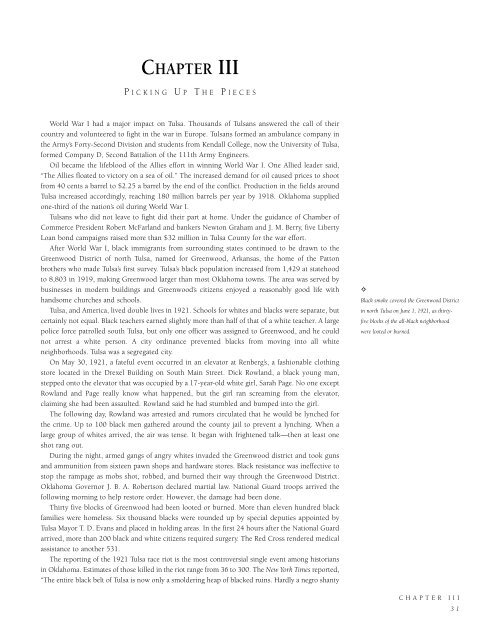Historic Tulsa
An illustrated history of the city of Tulsa, Oklahoma, paired with the histories of companies, families and organizations that make the region great.
An illustrated history of the city of Tulsa, Oklahoma, paired with the histories of companies, families and organizations that make the region great.
Create successful ePaper yourself
Turn your PDF publications into a flip-book with our unique Google optimized e-Paper software.
CHAPTER III<br />
P ICKING U P T HE P IECES<br />
World War I had a major impact on <strong>Tulsa</strong>. Thousands of <strong>Tulsa</strong>ns answered the call of their<br />
country and volunteered to fight in the war in Europe. <strong>Tulsa</strong>ns formed an ambulance company in<br />
the Army’s Forty-Second Division and students from Kendall College, now the University of <strong>Tulsa</strong>,<br />
formed Company D, Second Battalion of the 111th Army Engineers.<br />
Oil became the lifeblood of the Allies effort in winning World War I. One Allied leader said,<br />
“The Allies floated to victory on a sea of oil.” The increased demand for oil caused prices to shoot<br />
from 40 cents a barrel to $2.25 a barrel by the end of the conflict. Production in the fields around<br />
<strong>Tulsa</strong> increased accordingly, reaching 180 million barrels per year by 1918. Oklahoma supplied<br />
one-third of the nation’s oil during World War I.<br />
<strong>Tulsa</strong>ns who did not leave to fight did their part at home. Under the guidance of Chamber of<br />
Commerce President Robert McFarland and bankers Newton Graham and J. M. Berry, five Liberty<br />
Loan bond campaigns raised more than $32 million in <strong>Tulsa</strong> County for the war effort.<br />
After World War I, black immigrants from surrounding states continued to be drawn to the<br />
Greenwood District of north <strong>Tulsa</strong>, named for Greenwood, Arkansas, the home of the Patton<br />
brothers who made <strong>Tulsa</strong>’s first survey. <strong>Tulsa</strong>’s black population increased from 1,429 at statehood<br />
to 8,803 in 1919, making Greenwood larger than most Oklahoma towns. The area was served by<br />
businesses in modern buildings and Greenwood’s citizens enjoyed a reasonably good life with<br />
handsome churches and schools.<br />
<strong>Tulsa</strong>, and America, lived double lives in 1921. Schools for whites and blacks were separate, but<br />
certainly not equal. Black teachers earned slightly more than half of that of a white teacher. A large<br />
police force patrolled south <strong>Tulsa</strong>, but only one officer was assigned to Greenwood, and he could<br />
not arrest a white person. A city ordinance prevented blacks from moving into all white<br />
neighborhoods. <strong>Tulsa</strong> was a segregated city.<br />
On May 30, 1921, a fateful event occurred in an elevator at Renberg’s, a fashionable clothing<br />
store located in the Drexel Building on South Main Street. Dick Rowland, a black young man,<br />
stepped onto the elevator that was occupied by a 17-year-old white girl, Sarah Page. No one except<br />
Rowland and Page really know what happened, but the girl ran screaming from the elevator,<br />
claiming she had been assaulted. Rowland said he had stumbled and bumped into the girl.<br />
The following day, Rowland was arrested and rumors circulated that he would be lynched for<br />
the crime. Up to 100 black men gathered around the county jail to prevent a lynching. When a<br />
large group of whites arrived, the air was tense. It began with frightened talk—then at least one<br />
shot rang out.<br />
During the night, armed gangs of angry whites invaded the Greenwood district and took guns<br />
and ammunition from sixteen pawn shops and hardware stores. Black resistance was ineffective to<br />
stop the rampage as mobs shot, robbed, and burned their way through the Greenwood District.<br />
Oklahoma Governor J. B. A. Robertson declared martial law. National Guard troops arrived the<br />
following morning to help restore order. However, the damage had been done.<br />
Thirty five blocks of Greenwood had been looted or burned. More than eleven hundred black<br />
families were homeless. Six thousand blacks were rounded up by special deputies appointed by<br />
<strong>Tulsa</strong> Mayor T. D. Evans and placed in holding areas. In the first 24 hours after the National Guard<br />
arrived, more than 200 black and white citizens required surgery. The Red Cross rendered medical<br />
assistance to another 531.<br />
The reporting of the 1921 <strong>Tulsa</strong> race riot is the most controversial single event among historians<br />
in Oklahoma. Estimates of those killed in the riot range from 36 to 300. The New York Times reported,<br />
“The entire black belt of <strong>Tulsa</strong> is now only a smoldering heap of blacked ruins. Hardly a negro shanty<br />
✧<br />
Black smoke covered the Greenwood District<br />
in north <strong>Tulsa</strong> on June 1, 1921, as thirtyfive<br />
blocks of the all-black neighborhood<br />
were looted or burned.<br />
CHAPTER III<br />
31
















